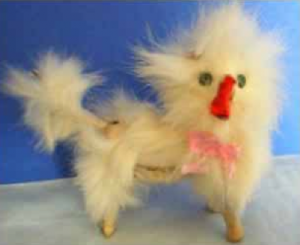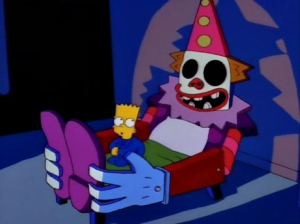In December 2005 researchers at England’s University of Bath released the results of a study that found that children, especially girls, see torturing and mutilating their Barbies as a common and enjoyable form of play. An article in the London Times stated that “mutilation ranged from cutting off hair to decapitating and putting the dolls in microwaves.” Children ages seven to eleven were said to “see Barbie torture as a legitimate play activity, and see the torture as a ‘cool’ activity,” according to the article. The children were aware that they were being exploited by “over-marketing and over-charging” and that rejecting the doll was a “rite of passage” engaged in by children who felt they’d outgrown their Barbies. “Barbies are not special,” said the researchers. “They are disposable, and are thrown away and rejected.”
I’ve thought about my history with Barbies, and my daughter’s, too, and I take issue with some of the article’s findings. Cutting Barbie’s hair isn’t really an act of mutilation in the way that putting her in the microwave is. Children know that cutting their own hair gets them in trouble, and cutting Barbie’s hair gives them the satisfaction of distorting her appearance and messing with the standard and approved way of viewing her, it’s true—it also lets them know what it feels like to cut hair without getting in trouble. The Barbies I grew up around often had missing toes; this is not because we wanted to bind their feet golden-lotus–style and further fetishize their sexual-fantasy-based bodies, but rather because chewing the rubbery plastic felt good. Gnawing away at them resulted in their coming off completely in the mouth in a pleasant if slightly disturbing fashion. Pulling Barbie heads off was common when I was a child, not because we were acting out scenes from Robespierre’s Reign of Terror but because we wanted to trade them around among dolls with different features and outfits. We also pierced our dolls’ ears (leaving them looking grey and infected) and bent their knees back and forth so much for the sheer pleasure of hearing the click click click of their joints that their skin tore.
But do people take pleasure in creating their own torture tableaux featuring Barbie, Ken and all their plastic molded-bodied friends? Of course. Their constantly perky expressions and injection-molded perfection do invite children to challenge their prefab poise. They look so inviting in the box, but take them out of the vivid fuchsia packaging and their clothes are hard to put on, and their hair gets bunched up and never lies flat again and gets permanently dull and stringy when Barbie is invited to play in the bathtub. Ken’s spray-painted hair wears off and he ends up with flesh coloring showing through in patches that have nothing to do with standard male-pattern baldness. Barbie is not only free of genitalia, but sometimes has molded skin-colored patterns simulating underwear built right into what would be her buttocks if she had any gluteal musculature.
Barbie’s original design was based on that of the Bild Lilli, a sexually suggestive German doll from the 1950s. A German brochure from the 1950s states that Lilli was “always discreet,” and that her wardrobe made her “the star of every bar.” When Barbie debuted in 1959, many parents found her obviously sexual nature disturbing. Of course, this aspect of her is partly what has always made her so alluring to children. She’s the premiere socially sanctioned sexualized plaything, and she allows young children to engage in pre-sexual roleplay and pretend to embody the roles they think are expected of them as they mature. Children live out stereotypes with Barbies, but they also challenge and laugh at them.
The widespread delight that children take in trashing their Barbies when they feel they’ve outgrown them might be a reaction to the stereotypes, the expectations and the mass-merchandizing overconsumption extravaganza that Barbie represents, at least in part. But often Barbie’s mutilation is an unintentional byproduct of trying to personalize her and make her more interesting and individual. When such an attempt results in a Barbie who is less appealing, her loss of allure and inability to be made into something uniquely appealing make Barbie a sorry remnant of a time of earlier naivete, as well as a reminder of failed attempts at creating more individualized beauty. Rather than feel bad every time we see what our attempts at beautification have done, it’s easier to dissociate her from her former status as beauty icon if we take her destruction even further. If she’s ugly and all the gloss and perfection that we once admired in her is gone, why not turn her into a doggy chew toy, or see what happens if we take nail polish remover to the paint on her face? If we turn her into a science experiment, we feel less disappointed in her lost glory.
Barbie’s reputation for mindlessness was bolstered by the 1992 release of Teen Talk Barbie. This talking Barbie spewed forth phrases like “Math is hard!” and “Will we ever have enough clothes?” A group calling itself the Barbie Liberation Organization soon became famous for engaging in acts of Barbie sabotage, exchanging Barbie’s talking guts for the voice hardware found in Mattel’s Talking G.I. Joe dolls. The BLO repackaged three hundred dolls and slid them back onto store shelves. When unsuspecting little girls tried their new Barbies at home, the fashion dolls grunted out “Vengeance is mine!” and “Dead men tell no tales,” while little boys’ new G.I. Joes cooed “Let’s plan our dream wedding!”
Of course, some toys are less than glorious to begin with, and only become more disturbing or ridiculous with time. Others begin attractively and grow frightening with disuse or misuse. Such are the toys found at DisturbingAuctions.com. The site’s home page states that Disturbing Auctions “is dedicated to the research and study of the most bizarre items found for sale on Internet auction sites. Not the obviously fake auctions, like the infamous human kidney, but truly tacky stuff that people really, honestly, believed that someone would (and in some cases did) buy.”
DisturbingAuctions.com features home furnishings including the velvet painting of Jesus blessing an 18-wheeler; accessories like the purse made of a bull’s scrotum; clothing like used gym shorts and a matching used jock strap; and haute cuisine, including 200 freeze-dried pork chops. But nothing can compare to discovering the hideous figurines, including the “Check Out My Ass Clown” (make sure to look at the optional magnified view for ultimate flamboyant clown perusing pleasure), the items classified as Terrifying Dolls, or, my favorites, the Emotionally Scarring Toys.
The Terrifying Dolls category features the pained, shriveled and body-part-challenged Puppet Assortment, the pinheaded Li’l Head Doll, and Baby Tears-Your-Flesh, a.k.a. Little Dolly No-Head. Big Hands Baby and the Saddam Hussein puppet also get honorable mention.
Clowns have a special place on Disturbing Auctions; here you’ll find a clown brooch, a clown ashtray and a vicious Cranky Clown Lava Lamp, among other items. Dead stuffed frogs also have their places, as does the stuffed and mounted genuine Deer Butt. The Clark Gable candle puts one in mind of a wax-covered severed head, and why the seller of the Inflatable Ladies’ Legs had to mention that they fit in the mouth when not inflated is anyone’s guess.
Still, the Emotionally Scarring Toys is the biggest, juiciest treasure trove of outrageous kitsch. From the Dean Martin Hand Puppet to our beloved Big-Ass Donkey, from Darth Small to the marvelously named Pooduck, it’s hard to find an entry that isn’t deeply, horribly, hideously wrong down to its very core.
While most of the site has stayed static for years, there is a related site, DisturbingAuctions.com/daily, where visitors can post their own horrific online auction discoveries and attach their own witty (or, more frequently, just vulgar) commentaries. There are occasional gems to be found here, but the older, original DisturbingAuctions.com site has the most consistently hideous and perfectly captioned offerings. All hail the Pooduck!
[Revised from an article which originally appeared on Laura Grey’s Little Hopping Bird blog.]


